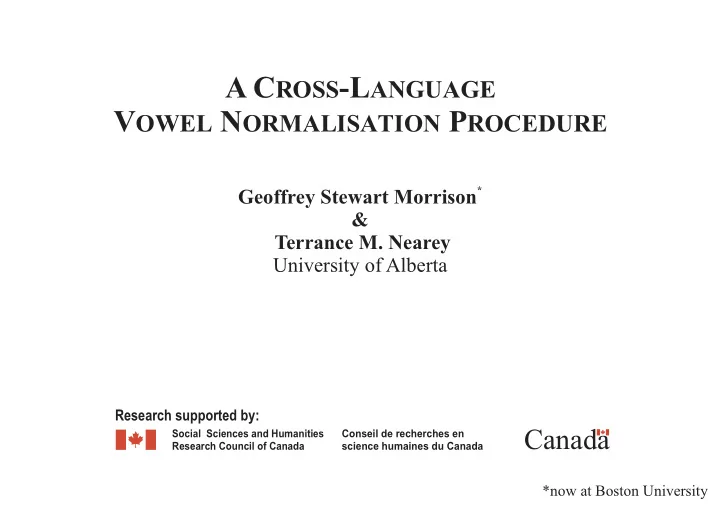

A C ROSS -L ANGUAGE V OWEL N ORMALISATION P ROCEDURE * Geoffrey Stewart Morrison & Terrance M. Nearey University of Alberta Research supported by: Social Sciences and Humanities Conseil de recherches en Canada Research Council of Canada science humaines du Canada *now at Boston University
Single language/dialect ln(F2) ln(F1)
Single language/dialect vocal-tract length differences ln(F2) ln(F1)
ln(F1) = ln(F2) Log-mean normalisation Nearey (1978) deviation from speaker mean ln(F2) ln(F1)
Log-mean normalisation slide so speaker means have same ln(F2) reference value ln(F1)
Log-mean normalisation deviation from language/dialect reference value ln(F2) ln(F1)
Making a number of simplifying assumptions about language and dialect differences:
Multiple languages/dialects differences in inventory pattern number and Language A ln(F2) distribution of log mean phonemes (size & skew) affect Language B speaker means log mean ln(F1)
Ideal bilingual G L due to inventory differences, not ln(F2) inter language correction vocal tract differences G L ln(F1)
Ideal bilingual Estimate G L from balanced samples of speakers from ln(F2) inter language correction each language G L ln(F1)
Cross-Language Vowel Normalisation: perception of an instance of a vowel from languge B (Spanish) in terms of vowel categories from language A (English)
log-mean normalise all English speakers’ vowels, ln(F2) train model ln(F1)
normalise a single token of a Spanish vowel ln(F2) ln(F1)
Within-language normalised ln(F2) within-language normalised token of a Spanish vowel ln(F1)
Cross-language normalised ln(F2) add/subtract G L ln(F1) G L
Evaluation data: � � � � English: / /, / /, / /, / / Spanish: / /, / /, / / � �� � Acoustic variables: F1, F2 at 25% duration of vowel Δ F1, Δ F2 (difference from 25-75% duration of vowel) duration
Statistical model: discriminant analysis trained on English vowels used to classifiy instances of Spanish vowels a posteriori probabilities (APPs) 3 versions: non-normalised ● within-language normalised ● cross-language normalised ●
Monolingual English listeners: classified instances of Spanish vowels in terms of English vowel categories proportions (pooled across listeners) Test value: correlation between model APPs and listener proportions
Results: model correlation ● non-normalised r = .848 ● within-language normalised r = .853 r = .869 ● cross-language normalised
Conclusion: The cross-language vowel normalisation procedure increased the correlation between the classification of Spanish vowels by a model trained on L1-English vowel productions and L1-English listeners’ perception of Spanish vowels.
3200 2800 Eng ��� 2400 Eng ��� Sp ��� Sp ���� F2 (Hz) 2000 Eng ��� Sp ��� 1800 Eng ��� 1600 1400 1200 250 300 350 400 450 500 600 700 800 900 F1 (Hz)
200 180 160 140 Sp ���� duration (ms) 120 Eng ��� Eng ��� 100 Sp ��� Eng ��� 80 Sp ��� Eng ��� 60 40 250 300 350 400 450 500 600 700 800 900 F1@25% (Hz)
15 10 Canonical Discriminant Function 2 5 0 -5 -10 -15 -20 -15 -10 -5 0 5 10 15 20 Canonical Discriminant Function 1
10 5 Canonical Discrimiant Function 2 0 -5 -10 -15 -20 -25 -20 -15 -10 -5 0 5 10 15 20 Canonical Discrimiant Function 1
Listeners Produced Perceived Eng / � / Eng / � / Eng / � / Eng / � / Sp / � / .951 .036 .009 .004 Sp / �� / .005 .003 .982 .010 Sp / � / .004 .275 .473 .248 Model Produced Perceived Eng / � / Eng / � / Eng / � / Eng / � / Sp / � / .997 .001 .001 Sp / �� / 1.000 Sp / � / .014 .583 .286 .117
Recommend
More recommend